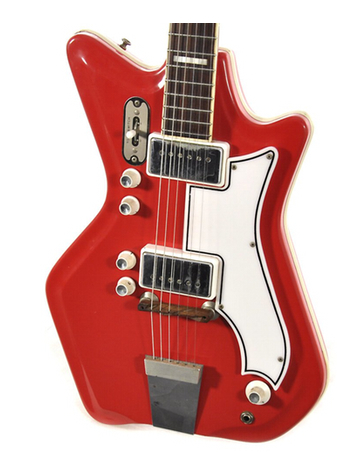"I play really old guitars; plastic guitars,” says Jack White in the documentary "It Might Get Loud". White is referring to his oddly-shaped red guitar bearing the name "Airline" on its white headstock. He particularly enjoys the struggle in playing this unconventional-looking guitar. "If you want it easy, buy a brand new Les Paul or a brand new Stratocaster," White says half-jokingly.
Jack White has become synonymous with the red Airline guitar model, originally manufactured by the Valco Guitar and Amplifier Company in the 1960s. Before the days of purchasing instruments online, players that couldn't afford a Gibson or Fender guitar sought cheaper alternatives. For White and many others, obtaining a guitar meant choosing between two of America’s biggest retail stores.
"Sears sold Silvertones and Montgomery Ward sold Airlines," White says. At the time, both retailers sold a variety of low budget guitars and amplifiers aimed at beginners, and their mail-order catalogues were crucial for reaching musicians in rural areas that could not travel to major cities.
Having several unofficial names, the red Valco Airline guitars were first known as the "JB Hutto Model," named after the blues guitarist known for using them. As the popularity of The White Stripes grew, some have referred to them as the "Jack White Model." Others may have referred to the guitar as the "Montgomery Airline" or "JB Hutto Montgomery Airline."

As part of The White Stripes, White played his Airline for nearly 10 years. He describes his guitar as a "hollow piece of plastic." The red plastic guitar body is made of two pieces called Res-O-Glas, a type of fiberglass. A narrow piece of maple runs down the middle of the body to anchor the neck, pickups and tailpiece. The Valco Airlines didn’t have a truss rod; instead, the neck was kept sturdy with reinforced steel. Quirkier still, the guitar only had 20 frets.
The controls are a bit puzzling for some players. Each pickup has a dedicated volume and tone control, but a master volume control sits next to the input jack. The volume and tone controls are above each pickup, next to the selector switch. While the pickups were made to look like large humbuckers, they are actually single coils that churn out a round and chimey sound."
Eastwood Guitars acquired the rights to the Airline name and have been producing their own models since 2001. These models have an adjustable truss rod, mahogany body (as opposed to the Res-O-Glas) and two humbuckers. There are some slight cosmetic differences, such as the greenish tuning pegs on the headstock as well a more Gibson-style inlay design. The original Valco Airline guitars were made in the US; Eastwood Guitars’ Airline models are made in South Korea and China.
The price for a Valco Airline guitar in 1964 was $99. Today, these guitars sell anywhere from $1500 to $3000 thanks to guitarists like JB Hutto and Jack White. Of course, if you can’t find a Valco model or your budget calls for a less expensive instrument, there are still plenty of Eastwood Airline guitars around.
While White is most closely with the Airline, he's also been seen with onstage with a Fender Telecaster and a number of Gretsch guitars including a modified double jet with a built-in MXR micro-amp. Staying true to his affinity for "department store guitars," White has had his share of Kay hollowbodies as well as a Harmony Rocket hollowbody. With Acoustics, White is known to play a Gibson Hummingbird, an antique Gibson L-1, and a white Grestch Rancher.
Amp wise, White has relied on a vintage mid '60s Silvertone 1485 tube head from Sears, as well as a 1970s Fender Twin Reverb. To get his fuzzier tones, White's pedalboard contains a Big Muff from Electro-Harmonix which, combined with a Digitech Whammy pedal, puts out some of his wilder guitar tones. For the track "Blue Orchid", White used an MXR Blue Box to get the song's fuzzy, octave riff.
